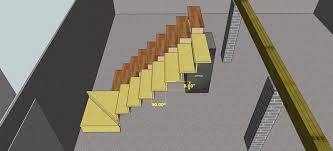Moving basement stairs can be a challenging and time-consuming task, but it is often necessary when remodeling or renovating a basement. Whether you need to move the stairs to create more living space or to improve the flow of your home, careful planning and execution are essential to ensure a safe and successful project. In this article, we’ll explore the steps involved in moving basement stairs.
Step 1: Assess the existing stairs and space
Before you can begin moving your basement stairs, you’ll need to assess the existing stairs and the space around them. Start by measuring the width and height of the current stairs, as well as the distance between the top of the stairs and the floor above. This will help you determine how much space you’ll need to move the stairs to a new location.
You’ll also need to consider the structure of your home and any load-bearing walls or beams that may be affected by the stair move. Consult with a professional if you’re not sure whether moving the stairs will affect the structural integrity of your home.
Step 2: Plan the new stair location
Once you have a good understanding of the existing stair location and the space available, you can begin planning the new stair location. Look for areas in your basement where the stairs will fit comfortably without impeding on living space or creating awkward traffic flow.
Keep in mind that the new stair location should also provide adequate headroom and follow local building codes and regulations.
Step 3: Create a new stair opening
To create a new stair opening, you’ll need to first remove the old stair treads and risers. Use a reciprocating saw or circular saw to carefully cut away the treads and risers, taking care not to damage any surrounding framing or electrical wires.
Next, use a chalk line to mark the new stair opening on the basement floor. Cut through the concrete floor using a concrete saw, and remove any debris from the opening.
Step 4: Build the new stair framing
With the new stair opening in place, you can begin building the new stair framing. This will involve building a new stair stringer, which is the support structure for the stair treads and risers.
Measure the distance between the floor above and the new stair opening, and use this measurement to calculate the length of the new stair stringer. Use a framing square and saw to cut the stringer from a piece of 2×12 lumber.
Next, install the stringer using metal stair brackets or wooden blocking. The stringer should be securely anchored to the basement floor and the floor above.
Step 5: Install the new stairs
Once the new stair framing is in place, you can install the new stairs. Use a circular saw or jigsaw to cut the stair treads and risers to size, and attach them to the stringer using construction adhesive and screws or nails.
Check the stairs for level and adjust as necessary. You may also need to install a handrail or balusters to meet building codes and improve safety.
Step 6: Finish the new stair opening
With the new stairs in place, you can finish the new stair opening. Install new drywall or paneling to cover any exposed framing, and finish the edges of the opening with trim.
You may also need to add lighting or ventilation to the new stair location, depending on the size and layout of your basement.
Step 7: Remove the old stairs
Finally, you’ll need to remove the old stairs. This may involve cutting away any remaining framing or supports, and carefully removing the stairs themselves. Be sure to dispose of any debris in accordance with local regulations.
It’s important to note that moving basement stairs is a complex and challenging project that should not be undertaken lightly. If you’re not experienced in construction or remodeling work, it’s best to consult with a professional contractor who can help guide you through the process and ensure a safe and successful outcome.
Tips for moving basement stairs
Here are some additional tips to keep in mind when moving basement stairs:
Take your time. Moving basement stairs is a complex project that requires careful planning and execution. Rushing the job can lead to mistakes and safety hazards.
Measure twice, and cut once. Accurate measurements are critical to ensuring that your new stairs fit properly and meet building codes.
Use the right tools and materials. Cutting through concrete, framing new stairs, and installing drywall all require specialized tools and materials. Be sure to have the right equipment on hand before you begin.
Follow building codes and regulations. Building codes vary by location, so be sure to check with your local building authority to ensure that your new stairs meet all relevant codes and regulations.
Consider professional help. If you’re not experienced in construction or remodeling work, it’s best to consult with a professional contractor who can help guide you through the process and ensure a safe and successful outcome.
In conclusion, moving basement stairs can be a challenging but rewarding project that can transform your basement into a more functional and attractive space. By carefully planning and executing the project, and following proper safety guidelines and building codes, you can create a new stair location that meets your needs and enhances the value of your home.

